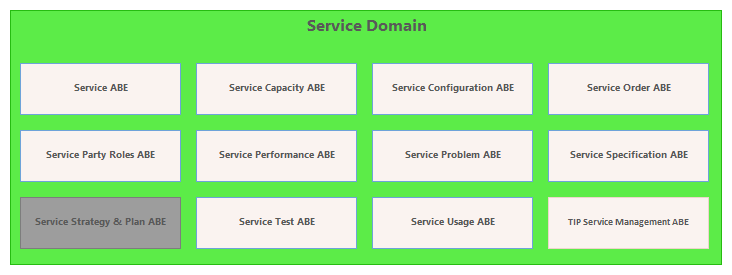Figure [SeD-01] Service ABEs Level 1

|
Project:
|

Figure [SeD-01] Service ABEs Level 1 : Class diagram
The diagram below lists the Service Domain's ABEs.<br/><b>Service Party Roles ABE</b><br/><ul>
<li>The Service Party Roles ABE contains all PartyRoles related to the Service Domain such as ServiceManager.</li></ul> <b>Service Specification ABE</b><br/><ul> <li>The Service Specification ABE contains entities that define the shared characteristics of both types of Service entities. This enables multiple instances to be derived from a single specification entity. In this derivation, each instance will use the characteristics defined in its associated specification.</li></ul> <b>Service Order ABE</b><br/><ul> <li>The Service Order ABE contains all entities that represent a type of Request of one or several services for any type of Service Specification. A Service Order decomposes a Product Order's products into the services associated with a ServiceOrder through which the products are realized.</li></ul> <b>Service ABE</b><br/><ul> <li>A Service represents an instance of ServiceSpecification. The Service ABE contains entities that are used to represent both types of Services: CSP Know-Hows instances (a.k.a. Customer Facing Services or CFS) and Technical solution (a.k.a. Resource Facing Services or RFS). </li><li>The Service carries the place where the Service is in use if relevant, as well as configuration characteristics, such as assigned telephone numbers and internet addresses. The Service also tracks the links to Product realized and/or Resources used.</li></ul> <b>Service Configuration ABE</b><br/><ul> <li>The Service Configuration ABE represents the specification of the different possible Service configurations as well as the Service Configurations instantiated for a Service.</li></ul> <b>Service Test ABE</b><br/><ul> <li>The Service Test ABE defines measurement including units and values and how the values are determined. It also includes thresholds used to evaluate the measure and the consequences of violating the thresholds as well as the Service Test measures that reflect the functioning of the Service under test.</li></ul> <b>Service Usage ABE</b><br/><ul> <li>The Service Usage ABE represents the specification of Service Usage types and collects Service Usage records with their characteristics (a.k.a. consumption data).</li></ul> <b>Service Performance ABE</b><br/><ul> <li>The Service Performance ABE collects information used to correlate, consolidate, and validate various performance statistics and other operational characteristics of Know-Hows (a.k.a. CFS) and Technical Solutions (a.k.a. RFS).</li></ul> <b>Service Problem ABE</b><br/><ul> <li>The Service Problem ABE manages faults, alarms, and outages from a Service point-of-view. This is then correlated to trouble tickets, regardless of whether the cause is physical or logical.</li></ul> <b>Service Capacity ABE</b><br/><ul> <li>The Service Capacity ABE specifies ability of Service to provide capability measured in quantity and units of quantity over an extended period. It also manages the Service Capacity Demands.</li></ul> <b>Service Strategy and Plan ABE (not fully developed)</b><br/><ul> <li>The Service Strategy and Plan ABE contains entities that are used to address the need for enhanced or new Services, as well as the retirement of existing Services, by the enterprise. These entities have a strong dependency to both entities in the Resource and Product domains.</li></ul> <i><br/></i><i>Note: TIP Service Management ABE is likely to be deprecated.</i><br/> |
